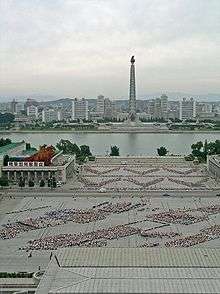Kim Il-sung Square
| Kim Il-sung Square | |
.jpg) | |
| Korean name | |
|---|---|
| Chosŏn'gŭl | 김일성광장 |
| Hancha | 金日成廣場 |
| Revised Romanization | Gim Il-seong Gwangjang |
| McCune–Reischauer | Kim Il-sŏng Kwangjang |
Kim Il-sung Square is a large city square in the Central District of Pyongyang, North Korea,[1] and is named after the country's founding leader, Kim Il-sung. The square was constructed in 1954 according to a master plan for reconstructing the capital after the destruction of the Korean War.[1] It was opened in August 1954.[2] The square is located on the foot of the Namsan Hill,[1] west bank of the Taedong River, directly opposite the Juche Tower on the other side of the river. It is the 37th largest square in the world, having an area of about 75,000 square meters (807,293 square feet) which can accommodate a rally of more than 100,000 people.[3][4] The square has a great cultural significance, as it is a common gathering place for rallies, dances and military parades and is often featured in media concerning the DPRK.
Overview
The Kim Il-sung Square is located at the center of Pyongyang on the west bank of the Taedong River. It is similar in form and design to the Tiananmen Square in Beijing and is used for the same purposes. Since the completion of the square, multiple parades have been held to commemorate many different events and also to show the world the military capabilities of the DPRK. The Kim Il-sung Square is architecturally more refined with its dramatic riverside setting. If one stands in the square, the Tower of the Juche Idea on the opposite bank appears to sit at the other end of the square, although it is actually across the river, similar to the Workers' Party Monument and the Mansudae Grand Monument. The optical effect is achieved since the square is a few meters lower in the middle than near the waterside. Surrounding the square are a number of government buildings, with the Great People's Study House sitting at the "head" of the square.
Portraits of Kim Il-sung and Kim Jong-il are displayed on buildings surrounding the square where portraits of Karl Marx and Vladimir Lenin once hung. During Kim Jong-il's rule, only Kim Il-sung hung on these buildings, as his portrait does in every room in North Korea, however, when Kim Jong-il died, his portrait was added to the buildings in commemoration.
Gallery
- Pyongyang as seen from the Juche Tower, facing west across the Taedong River. The large square in the centre is Kim Il-Sung Square; the large building behind it is the Grand People's Study House.
 The Kim Il-sung square, with the Grand People's Study House, also known as the National Library of the DPRK, in the centre, as viewed from the top of the Juche tower in Pyongyang
The Kim Il-sung square, with the Grand People's Study House, also known as the National Library of the DPRK, in the centre, as viewed from the top of the Juche tower in Pyongyang- The Kim Il-sung Square across the Taedong River from the Juche Tower, Pyongyang.
 The Kim Il-sung square, as viewed from the Study Hall to the Juche Tower.
The Kim Il-sung square, as viewed from the Study Hall to the Juche Tower. The Kim Il-sung square. The structure on the right is the Grand People's Study House. The complex functions as a library and study hall.
The Kim Il-sung square. The structure on the right is the Grand People's Study House. The complex functions as a library and study hall.
References
- 1 2 3 "Kim Il Sung Square". Naenara. Retrieved 2015-12-05.
- ↑ Martin (2006), p. 774
- ↑ Pyongyang Images, New Korea Tours
- ↑ Kwan, Lee Kyo. Mammoth Underground Square and Road in Pyongyang. Digital Chosunilbo. July 22, 2001
Bibliography
- Martin, Bradley K. (2006) Under the Loving Care of the Fatherly Leader: North Korea And the Kim Dynasty. St Martins Press. ISBN 978-0-312-32322-6
External links
| Wikimedia Commons has media related to Kim Il-sung Square. |
- 360° Interactive panorama of Kim Il-sung Square at night images
- Asian Historical Architecture: Kim Il-sung Square images
- Traveller's blog with pictures from North Korea ; Several photos of Kim Il Sung Square.
- Kim Il-sung Square, Pyongyang, North Korea (video) — practising for the Mass games
Coordinates: 39°01′10″N 125°45′09″E / 39.01953°N 125.75247°E